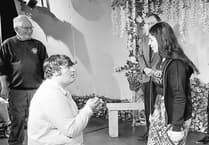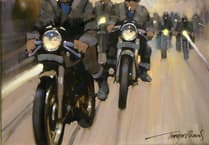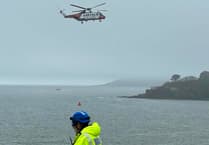Kingsbridge Cookworthy Museum is taking part in commemorations of the 80th anniversary of D-Day and the part played in it by Slapton.
The exhibition is called Six Weeks To Go as local residents who were evacuated from the Slapton area were given just six weeks to leave the area.


It has tapped into many of the museum’s collections: the image collection with photographs taken from the time of the evacuations in Slapton, Blackawton and East Allington.
There’s a Devonian WVS (Women’s Voluntary Service) costume, a land girl, a naval rating and a US officer.
Curator Kathy Courage explained: “We’ve done a timeline which talks about anticipating the war going back to 1938 when General Montgomery was here and they were looking at the area and its potential as a location for practices for D-Day landings practices.
‘”The troops arrived in 1943 then in November the whole area had to be evacuated.
“3,000 villagers were told they would have to leave and they had six weeks.
“From mid-November to December 20 was their time to go.
“Five days before Christmas you would have to up sticks not knowing when or even if you were going to return home.
In the event very few people got to return to their homes.
Kathy continued: “A lot of them were tenant farmers so they had to sell everything.
“If you could imagine down at Kingsbridge Quay everyone would be taking down their horses, their cattle their sheep and having to sell them at rock-bottom prices as with everyone wanting to sell they were knocking prices down and people were taking advantage of that.”
“The winter of 43/44 was one of the coldest the country had ever known but the stoicism and coming together of all those people was remarkable.
“It rolls round into 1944, the villagers have all gone and the Americans troops arrive followed by the exercises that take place.
“Exercise Tiger between April 22 and 30 was the most tragic.
“There seems to have been a mis-communication resulting in numerous German E-boats causing havock, sinking two of the LSD’s and badly damaging a third.
“749 men are known to have lost their lives but that figure could be much higher.”
“The Americans left at the end of the war and the area was repatriated.”
Another of the exhibits was a unique map which was found in a house in Sherford in the 1980s and was found by the present owner Sue Ward who has lent it to the museum.
The house was used as a key command centre during the operations.
Kathy said: “The red outline shows the whole area that was evacuated and the blue and green lines show the repatriation of the area.
“They cleared the area for people to move back.”
Next is a special display telling the story of a child called Amy Treeby.
A couple came into the museum in 2019 carrying a small leather suitcase which had been in an attic since 1944.
Kathy continued: “When the suitcase was opened it contained all all the belongings that Amy, who lived in Slapton, had packed when she was evacuated.
“Luckily Amy’s family were repatriated in Devon.
“Sadly Amy passed away in 2019 but we do have this wonderful treasure of hers which was a bit like opening up a time capsule.
“It felt spine-tingling when I started to curate the items.
“She chose her favourite games, her books, her knitting patterns, her Farmer’s Weekly which was dated the very month that they move
“We also have Amy’s Canadian Red Cross quilt which is one of six that we have and we know the details of the owners of all six. “One was owned by Albert Cleave, who is believed to have lied about his age so he could join the Home Guard and he kept it until he died in 2020 aged 94.”
In another cabinet is the story of the US troops with items such as the food rations, the battle dressings, the Signal Corps books, the tuck tin, the cigarettes and more.
Another section features the story of land girl Kay Sopher.
There are also oral histories of local people with period music.




